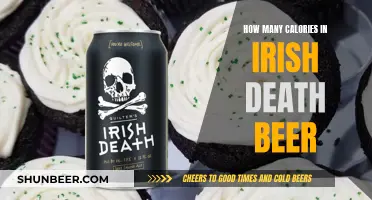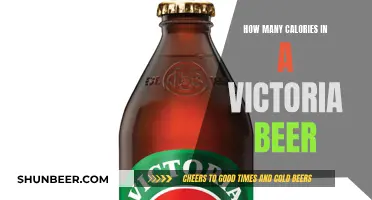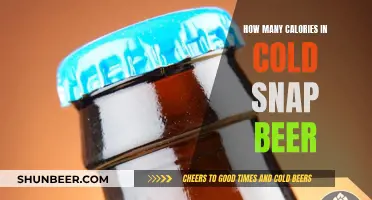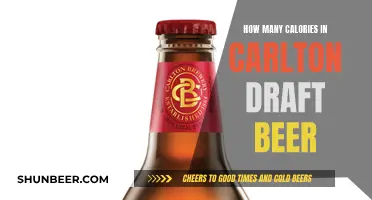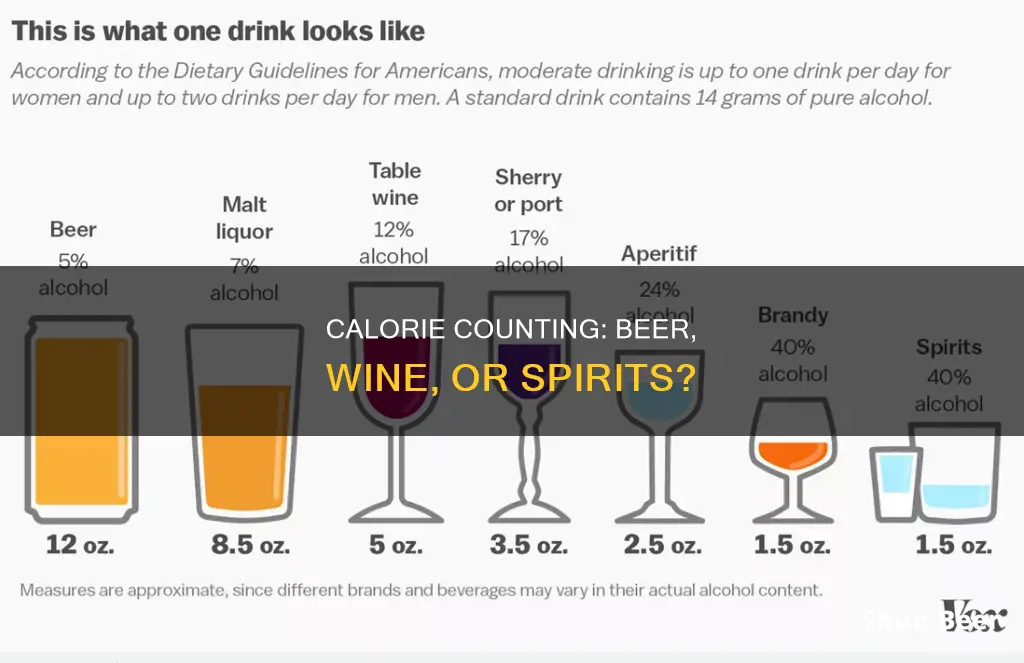
Alcoholic drinks can be high in calories, which can make it challenging to lose weight. While the calorie content of beer, wine, and spirits varies, some are more waistline-friendly than others. Spirits, such as vodka, gin, rum, whiskey, and tequila, are typically low in calories, with an average of 97 calories per 1.5-ounce shot. Wine and beer, on the other hand, can range from 60 to 300 calories, depending on various factors such as alcohol content, ingredient density, and type. So, when it comes to calories, spirits generally come out on top as the lowest-calorie option.
Beer, Wine or Spirits: Which Has the Least Calories?
| Characteristics | Values |
|---|---|
| Beer | 60-300 calories per serving |
| Wine | 70-210 calories per serving |
| Spirits | 96-97 calories per 1.5-ounce shot |
What You'll Learn

Beer has more calories than wine
When it comes to alcoholic drinks, it's clear that some are more waistline-friendly than others. Beer has more calories than wine, and this is largely due to the leftover carbohydrates in beer, as wine usually has a lower sugar content.
According to the NHS, a 175ml glass of 12% ABV wine contains around 133 calories, which is equivalent to eating three Jaffa Cakes. The calorie content varies depending on the type and colour of wine. Rosé wine, for example, has on average 70-80 calories per 100ml, while red wine tends to contain between 75-85 calories per 100ml. Red wine tends to have a higher alcohol content, and wines with a higher alcohol content will usually contain more calories.
On the other hand, a pint of 5% ABV beer contains around 240 calories. Lighter-coloured beers tend to contain fewer calories than their darker counterparts, as they have a lower alcohol content and lower ingredient density. For example, most light beers tend to have between 60 and 120 calories, while dark beers contain between 100 and 300 calories, as they are more carbohydrate-heavy.
The nutritional value of beer is higher than that of wine, with beer often containing protein, fibre, B vitamins, folate, and niacin. However, beer also tends to have a higher calorie content, giving some truth to the expression 'beer belly'. On average, a pint of beer has 50% more energy content than a small glass of wine, which can cause weight gain if consumed in excess.
Calories in Coors Banquet Beer: What's the Count?
You may want to see also

Spirits are a relatively lower-calorie option
The calorie content of beer and wine can vary depending on several factors, including the alcohol content, volume, and the presence of carbohydrates and sugars. Beer, which is made using grains and yeast, typically has between 4 and 7 percent alcohol by volume. The calorie content can range from 60 to 300 calories, depending on the type of beer. For example, light beers tend to have between 60 and 120 calories, while dark beers, which have more carbohydrates, can have between 100 and 300 calories.
Wine, on the other hand, typically has between 120 and 210 calories per six-ounce glass, depending on the alcohol content and ingredient density. Red wines have slightly more calories per ounce than white wines, with 25 calories per ounce compared to 24 calories per ounce for white wine. On average, a 175ml glass of 12% ABV wine contains around 133 calories.
While spirits have a higher alcohol content by volume, the volume of a standard shot is small, making them a relatively lower-calorie option. However, it's important to note that mixers can significantly increase the calorie count of a drink. Zero-calorie mixers, such as diet cola, soda water, or seltzer, can help keep the calorie count low.
If you're looking to make healthier choices when it comes to alcohol consumption, spirits like vodka, gin, tequila, or gin are a good option. However, as with all alcoholic beverages, moderation is key to maintaining a healthy lifestyle.
Carlton Dry Beer: Calorie Count and Health Facts
You may want to see also

Dark beers have more calories than light beers
It is a common misconception that dark beers are heavier than light beers. However, this is not always the case. While it is true that lighter colour beers tend to have fewer calories than their darker counterparts, it is not the colour of the beer that determines its calorie content, but rather its alcohol content.
Dark beers are made from heavily roasted grains, which give them their distinct chocolate and coffee flavours. The roasting process does not, however, add more alcohol to the beer. Therefore, stouts, porters, and black lagers that have an alcohol by volume (ABV) of around four to five per cent can have fewer calories than a light pilsner. For example, a serving of Guinness has 125 calories, while a Bud Light has 110.
The calorie content of beer is directly related to its ABV. The higher the ABV, the more maltose is needed to produce the beer, and the more calories the end product will have. So, if you're looking for a light beer in terms of calories, it's best to choose one with a lower ABV, regardless of its colour.
Beers with a lower ABV and fewer calories include black lagers (or schwarzbiers), porters, and dry stouts. These beers also tend to be light in body and highly carbonated, with little to no malt aroma or roasted flavours. Examples include the Schwartzbier by Duck-Rabbit Craft Brewery, Black Bavarian by Sprecher Brewing Co., and Session Black Lager by Full Sail Brewing.
So, if you're looking to cut down on calories but still want to enjoy a beer, don't write off the dark beers just yet!
Ghost in the Machine Beer: Calorie Breakdown and More
You may want to see also

Wine has a lower carbohydrate count than beer
When it comes to alcoholic drinks, it can be challenging to maintain a healthy lifestyle and still indulge. Alcohol doesn't provide nutritious calories, and consuming it can hinder weight loss. However, some alcoholic drinks are more waistline-friendly than others.
On the other hand, wine is made with fermented grapes, and the sugar content in wine is generally low. Any carbohydrates in wine consist of small amounts of sugar left over from the original grape sugar after fermentation or added to balance the acidity. Unless it's a dessert wine, the amount of sugar in wine is typically small and doesn't significantly contribute to its calorie count.
The calorie difference between beer and wine can be attributed to the leftover carbohydrates in beer, as wine usually has a lower sugar content. Beer is also typically served in larger volumes than wine. While a glass of wine is around 150ml, beer is often served in schooners or pints, which are 425ml and 570ml, respectively.
Wines can vary significantly in their carbohydrate content, mainly in the form of residual sugar. However, dry wines (where the fermentation process ran to completion) tend to be low in carbohydrates. Both dry red and white wines usually have between 0.5 and 2 grams of sugar per 150ml glass, resulting in only 2 to 8 calories from carbohydrates.
In contrast, beer is made from grains and has a significantly higher carbohydrate content. The yeast in the brewing process cannot ferment all the carbohydrates in the beer. Therefore, a 425ml schooner of beer contains 6 to 18 grams of carbohydrates, or 24 to 72 calories from carbs. Lighter beers like lagers and pilsners tend to have fewer carbohydrates, while heavier ales and dark beers have higher levels.
When it comes to weight loss, neither beer nor wine is a smart choice in excess. While wine has a lower carbohydrate count, it sometimes makes up for it in sugar content. Alcoholic drinks can hinder weight loss goals when consumed in large amounts, as they add extra calories without providing essential macronutrients like healthy protein, fat, or fiber. Therefore, moderation is key when including alcohol in your diet.
Java Beer Calories: Jabba the Hutt's Secret
You may want to see also

Alcohol is fat-free
Alcoholic drinks are known to be high in calories and can hinder weight loss goals. However, pure alcohol is fat-free. So why is alcohol consumption associated with weight gain?
Alcoholic drinks contain what are known as "empty calories", which provide no essential nutrients like healthy protein, fat, or fiber. These drinks can also be high in carbohydrates and sugars, which contribute to their calorie count. For instance, beer is made from grain, which stores carbohydrates in the form of starch. While wine has a lower sugar content, it still contains empty calories and carbohydrates.
The calorie count of alcoholic drinks varies according to several factors, including alcohol content, volume, carbohydrates, sugars, and mixers. Generally, the biggest difference in calories between drinks comes from the alcohol content. However, the presence of carbohydrates also contributes significantly to the calorie count, especially in beer.
Low-calorie beers have additional enzymes added during the brewing or fermentation process to break down starch molecules into simple sugars, leaving no remaining carbohydrates. These beers also have a relatively low alcohol content to keep the total calorie count low.
Spirits, such as vodka, tequila, rum, and gin, generally do not contain any carbohydrates or sugars. While they have a higher alcohol content, the volume of a standard shot is small, making them a relatively lower-calorie option.
When it comes to weight loss, it is important to remember that your regular drinking patterns matter more than the type of alcohol you're consuming. Excessive alcohol consumption can hinder weight loss goals, regardless of whether you're drinking beer, wine, or spirits. Moderation is key.
Calories in Anchor Steam Beer: What's the Count?
You may want to see also
Frequently asked questions
Spirits have the fewest calories, with an average of 97 calories per 1.5-ounce shot. Beer and wine have similar calorie counts, especially when comparing darker beers and heavier wines. A 12-ounce serving of beer typically has between 100 and 330 calories, while a 5-ounce glass of wine has between 120 and 210 calories.
Yes, darker beers tend to have more calories than lighter beers. This is because darker beers have a higher alcohol content and are more carbohydrate-heavy.
Yes, the calorie count of wine depends on the alcohol content and the type of grape used. Red wines tend to have slightly more calories than white wines, with rose and white wines having the fewest calories.
While alcoholic drinks are not nutritious and can hinder weight loss goals, some are more waistline-friendly than others. Lower-calorie options include spirits, champagne, dry wine, light beer, and reduced-calorie wine.
The calorie count of an alcoholic drink is influenced by various factors, including the amount of alcohol, the total volume of the beverage, and the amount of carbohydrates, sugars, and mixers. Generally, the biggest difference in calories comes from the alcohol content, with beverages having higher alcohol content typically containing more calories.


